AMD and Intel Mobile Rematch: Gateway NV5933u vs. Acer 5542
by Jarred Walton on June 18, 2010 1:14 AM ESTGeneral Application Performance Compared
With the general overview of the two laptops out of the way, it's time to look at performance numbers. Starting with our general application benchmarks, we expect the i3-330M to easily win in these tests, particularly if an application can leverage more than two CPU cores. The i3 line doesn't have the Turbo modes found on i5 processors, but you still get Hyper-Threading which is good for an extra 10-20% performance depending on the application.
[Note: We're still collecting the Toshiba A505 with M600 results; at this point, the A505 Futuremark results are preliminary scores, as we've only had a chance to run them once. We'll have the final results in the forthcoming review.]

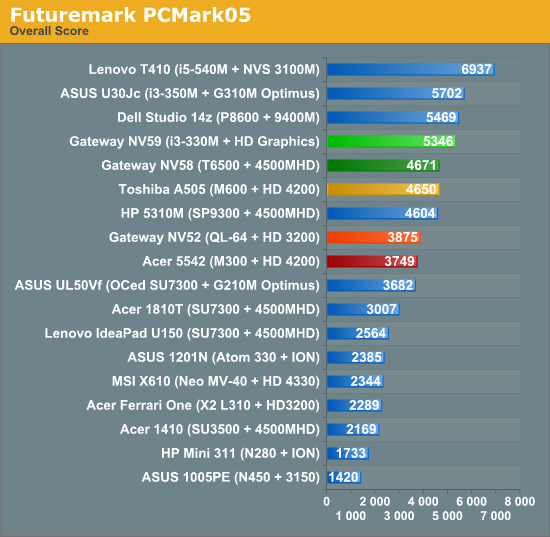
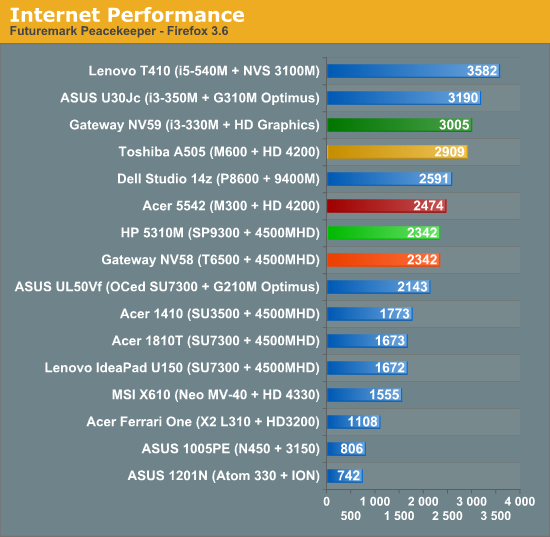
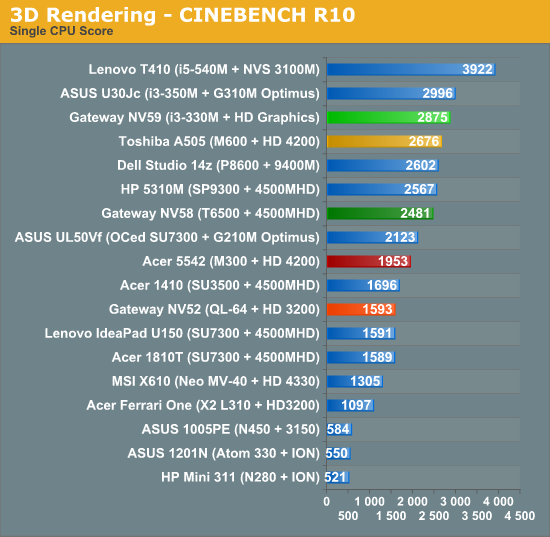
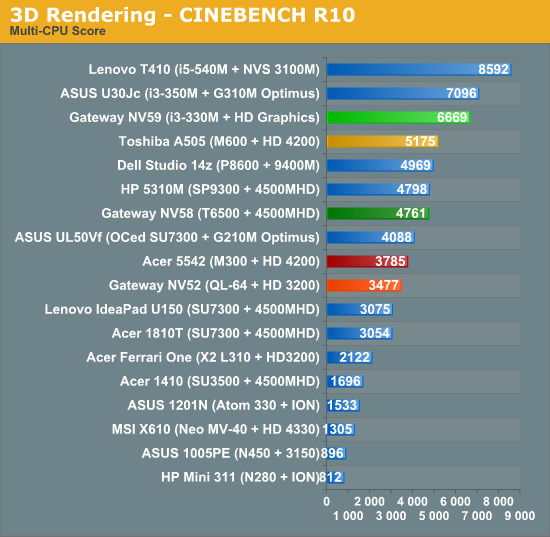
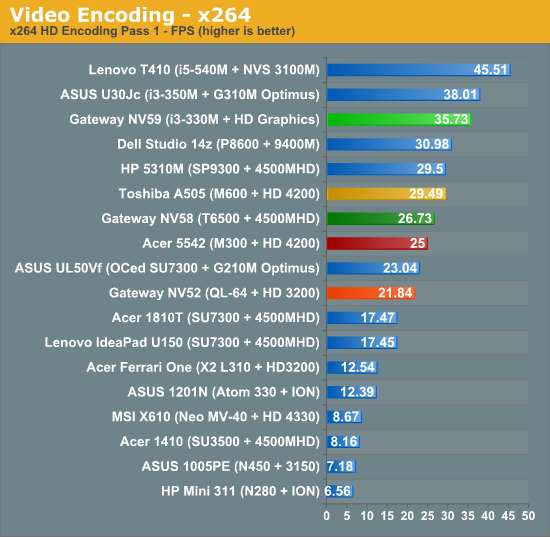

Let's start with PCMark, since it's a good representation of real world applications. PCMark puts the NV59 quite a bit ahead of the 5542, though with different hard drives there are other factors in play. The gap in Vantage is 52% while it's "only" 42% in 05, and in general use the NV59 certainly feels quite a bit faster. Results in the other application tests continue the trend of Intel leading in general performance. The closest score is in Peacekeeper, a single-threaded Internet benchmark, with the NV59 leading the 5542 by 21%. The x264 encoding advantage is 43% for pass one, and the second pass where multithreading really plays a role has the i3-330M leading by 73%. Cinebench is similar: 47% lead for i3-330M in single-threaded mode, and a 76% lead in the multi-threaded test.
It's no surprise that Intel is leading in CPU performance, as they've been ahead of AMD since Core 2 launched and Core i7/i5/i3 only increased that lead. That's not to say that the 5542 is slow, but the M300 isn't a very good competitor as far as general CPU performance is concerned. Clocked at 2.0GHz, architectural improvements make it slightly faster than the old QL-64, but chips like the M500 and M600 are much more competitive. We've included the Toshiba A5050 with a Turion II M600 for reference here, and it does much better. Of course Intel has plenty of faster CPUs as well—the i3-330M is their slowest i-Series processor. Anyway, as Atom has proven, if you're just surfing the Internet and running office applications any modern laptop is more than sufficient; these systems are substantially faster than netbooks and CULV laptops, so they're certainly in the category of "fast enough".
Also worth noting is the improvement in performance both platforms have shown relative to last year's models. We're using our Windows 7 results here, so the OS isn't a factor, and the basic entry-level AMD laptop is still 10-15% faster in many of the tests, even with a slightly lower clock speed. Clearly the change from an old K8-based architecture to the 45nm K10-based design helps, with PCMark05 being the only test where the 5542 didn't beat NV52. On the Intel side, the performance gap is much greater. The smallest gains are around 15% in single-core Cinebench and PCMark05. PCMark Vantage improves 33%, with Peacekeeper and x264 pass 1 around 30% as well. The biggest gains are in multi-threaded tests where Hyper-Threading is able to boost performance by up to 45% over the old T6500.
We also tested the latest release of Flash 10.1 with the latest drivers from both AMD and Intel. Unlike previous tests, all of our Flash video testing went off without a hitch—yes, even 1080p YouTube videos played in full screen mode without dropping frames. The NV5933u comes with a Blu-ray drive, and we also tested several Blu-ray movies, the most intensive being a 37Mbps AVC encode. There were no issues there either. But there's more to laptops than general performance, so let's look at a few other metrics.










38 Comments
View All Comments
frozentundra123456 - Friday, June 18, 2010 - link
I dont really understand the point of posting gaming scores with these laptops. Would anybody really game at 800x600 and minimun settings??? And nearly all the games are unplayable at the quite low native resolution on either platform.Roland00 - Friday, June 18, 2010 - link
As a computer salesperson the answer is yes. Most people who come in wanting this price point you can upsale to a better gaming laptop (or convince them to get a light to high gaming desktop instead), for honestly you get a much better experience for a few hundred more.That said I often have customers come in where they can't physically pay more (due to finances) or won't pay more. Often the end user (not necessary the buyer) is going to be a college student who is going to play WoW, or is going to be a teenager who wants to play some random computer game on his laptop.
OldPueblo - Friday, June 18, 2010 - link
Definitely, I have a great gaming rig at home and I don't need one in a laptop as well that will just sit and not be used when I'm at home (money wasted). All I care about is having fun in some games, not staring at eye candy. That's what my eyefinity setup is for. I played a game of COH last night on the $380 laptop I posted above, and it was just as fun as on my real system and was perfectly smooth but still looked just fine with all the detail on low. Once again I wasn't focused on whether or not my soldiers had visible uniform detail, I just wanted to have fun. Being able to do that on a laptop that cost the same as JUST my video card on my gaming rig (5870) is pretty amazing to me.Tewt - Sunday, June 20, 2010 - link
Ditto to what OldPueblo said. I already have a good gaming rig(Phenom II 920, 8GB RAM, Radeon 5850). I wanted something cheap to watch movies in bed(Netflix, Amazon On Demand, etc) plus something I could game on when I head over to a friends house or home where I can play CoH with my nephew. I was also able to turn down the graphics enough to get around 30-40fps at the full resolution 1366 x 768 but still 'good enough' details. Or I can play WoW with even higher framerates.I had been looking at netbooks mainly for their battery life but two things stopped me. One, no netbook should be above $299 imo and two, when reading reviews on retail websites only a few could handle streaming video. The ones that could usually conflicted with my first point. In comes the Acer Aspire 5551-2450. I couldn't beat the value I got for only $399. Granted my last laptop, which is still running, was a Dell Inspiron 700m(~$1200 at the time) so I was pretty blown away with what I received for such a low price. At that price, functionality won over portability, weight and battery life. Granted, if I were a road warrior and had to carry something around every day and didn't need much computing power beyond internet access and MS office functionality I would give a netbook much more serious thought. And let's face it, no matter the laptop, they are more portable than a full PC rig.
I've never bought Acer and I've read some bad comments yet they also have very good comments on Newegg. This is one of the few times I bought something before it had any reviews so I also purchased an extra year of warranty(hopefully the company Newegg picked is good if I need to use it) just in case.
If they had managed to put in bluetooth, e-SATA and/or an integrated microphone(mine looks like it has one but is either disabled purposely or missing the actual hardware as there is a tiny hole right next to the webcam but I see no way to enable it), they would never be able to keep this thing in stock for long at that price.
I was pleasantly surprised by the bootup speed(less than 30 seconds even with 68-74 processes running in the background), my first encounter with Windows Media Center, the LCD had a better viewing angle than I expected, the keyboard is spacious, I like the style of the individual keys, the trackpad is responsive without any unexpected behavior so far and pretty much stutter free playback of my videos, streaming from the net or my mediasmart server.
Couple things I 'felt' might cause future trouble. The build quality seems ok. This from picking it up on one side and feeling little flex in the casing. But what worries me are the hinges not lasting. They feel like they could possibly snap after a while. You need to grip the LCD just right so it does not flex awkwardly when pushing back the lid. In regards to the wireless, I'm currently using G speeds due to my U-verse modem and wonder how much trouble I will run into once I upgrade to an N router since the specs for this laptop mention Draft-N. How this spec is still available for a recently released laptop is a head-scratcher.
Fyi, this laptop model is already sold out on Newegg.
starfalcon - Tuesday, July 13, 2010 - link
I beat MW2 at 780x480 and just about minimum settings and enjoyed it a lot.Every game is different.
Obviously integrated graphics aren't made for serious enthusiast type games though, but hey better chances with games.
mino - Saturday, June 19, 2010 - link
This is what happens when you try to do it "on the cheap" and try to cover 3 incompatible topics into a single article:1) introduction and "comparison" of two SPECIFIC boxes Acer sent you
2) current state of the market Intel vis-a-vis AMD
3) abilities comparison of current Intel and AMD value paltforms
Each of these requires a different approach testing-wise, configuration/system wise as well as point-of-view wise.
End result is an (for a non-expert) incomprehensible article that barely does PR for the Gateway model covering partly 1) topic.
IF you ever get into the same situation, please do no repeat this attempt at hobbyist hybridization.
Split the information into AT LEAST 2 articles:
-------------------------------------------------
1) Apples-to-Apples comparison of 2 platforms along with associated market report
- this means identical HDD, DVD, battery, accessories, etc
- this means most gaming tests at native with older games
- this means NO LCD, WiFi, Bluetooth, WebCam tests or connectivity comparisons
2) Comparison of these 2 SPECIFIC systems themselves where performance is mentioned as secondary and most system specific things like LCD's are evaluated (so that Acer is happy and sends you new toys)
Here is an excerpt of bad part of the article: (FYI)
- you use incomparable units price-wise (they are not market-representative)
- you use incomparable units configuration wise (they are not platform-representative)
- you compare the 2 SPECIFIC units and forcibly "draw conclusions" for the whole market
- you screw the graphs with an unnecessarily huge amount of comparison points
- you fail to separate the tested candidates in the graphs
You have done MUCH better in the past. Hopefully, we will not have to suffer a repeat.
JarredWalton - Saturday, June 19, 2010 - link
I hardly think this qualifies as "lazy writing"... in fact, trying to condense more content into a single article would be the exact opposite. It's far easier to do two laptops separately than to do a head-to-head; I've done both, and it generally takes four times as long to do the head-to-head as it would have taken to do a single review--or twice as long as two separate reviews if you prefer.Beyond that, the laptops reviewed didn't come from the same source, even though Acer technically owns Gateway and makes both. The last time I did this sort of review, Gateway was good enough to send us both the Intel and AMD laptop; usually, that doesn't happen, and in this case the AMD laptop came from Acer via AMD. I'm also not sure how 2 and 3 in your list are even separate subjects.
I have my own critiques against the article, but most of that involves me not being able to get the exact hardware I wanted to test. While swapping HDDs, batteries, etc. would make it as equal as possible, I've looked at that in the past and found very little reason to go to extra measures. HDDs might make a small difference in PCMark, but that's about it.
I would argue that outside of price, these two laptops are viable candidates to represent the market, but the only way to know for sure is to test a LOT more laptops from each platform. Given the difficulty of acquiring AMD laptops, plus the fact that the Gateway is the sole Intel HD Graphics laptop (i.e. no Optimus or discrete GPU) we've had shipped our way, my real conclusion is this: these are commodity item laptops that the majority of manufacturers don't particularly care to have reviewed.
The graphs are always a tough call. If I remove "old" comparison points, people complain that we are only looking at a few options. If I leave them in, other people complain that they're information overload. I tried to include only laptops that are relatively competitive, with only one representative of major platforms on most tests. Which laptops do you think we should remove? I can make an argument for just about every one to stay or go.
The Toshiba A505, NV59, and 5542 all need to be there obviously, along with the NV52/NV58. Atom is the cheapest netbook option with good battery life, so it should stay. Atom + ION is also worthy of inclusion. CULV certainly needs to be in there at least once, and CULV + Optimus is a nice extra. Lenovo T410 is tough to justify, but it represents a higher-end i5 notebook. U30Jc is a good laptop that we recommend, so that should be in the charts. MSI X610 could go, but it's one of the few other AMD laptops we've tested; same for Ferrari One. Studio 14z is a better overall platform than any of the current Intel/AMD offerings in my book--a better GPU, and Core 2 Duo beats the new i3/i5 platforms. At this point, I figure leaving in a few other laptops doesn't hurt, but I could remove the T410, HP 4310m, Lenovo U150, MSI X610, 1201N, and Acer 1410 and not feel too bad.
As for the battery charts, the one thing I've come to know over the years of laptop testing is that even if two laptops are the same in terms of specs, they can have different battery life because of BIOS optimizations and other low level differences. So I leave in as many laptops as I feel reasonable. Lazy? Well, it's easier to trim out the extra stuff honestly, and I hope it helps people realize that just because laptops appear similar on the surface, there are often differences underneath.
Your accusation that I try to "forcibly draw conclusions" is exactly what I'm trying to avoid doing. I specifically DIDN'T come to a strong conclusion because without testing at least five candidates from each platform I just don't feel comfortable doing so. The only conclusions I drew were in regards to these two specific laptops. The NV5933u is a good buy at $550; the 5542, not so much. At $400-$450, it's also worth buying, depending on your needs. And since I'm only really able to analyze a couple specific candidates, there's no point in omitting other tests like the LCD.
What performance criteria did I neglect? Battery life, general apps, CPU, GPU are all covered. The LCD testing is almost an afterthought--I wrote two paragraphs and said both LCDs suck. Yeah, I'm sure that Acer is happy to see that LCD comparison and will now "send me new toys". Get real. Performance for a $500 really is a secondary consideration for 99% of buyers, and rightfully so! I'd take a well made but slower laptop any day over a faster laptop with a crappy keyboard and LCD. But few if any budget laptops are well made, so the point is moot.
Anyway, we're working to get more laptops, particularly AMD systems, and as we get those we can come to a few more conclusions. So far, though, outside of performance and price being acceptable, I don't think there's much to say about the new platforms relative to the old.
Shadowmaster625 - Monday, June 21, 2010 - link
That is a $329 notebook. http://tinyurl.com/25ypk7o (And this is an M320!) I have no trouble finding deals like that every time I look. That $329 notebook is being substituted for a full retail version ($500) from Amazon. And then you actually have the audacity(!) to compare that ripoff to an Intel notebook that, by your own admission, would normally retail for $749!! ($600 if you drop the BD and scrounge for deals.)So you are literally comparing an Intel notebook that is twice as expensive as the AMD, and seriously gaming the numbers to try and cover that up. What is the point in doing that when it is transparently obvious?
JarredWalton - Monday, June 21, 2010 - link
I know you love to be biased against Intel, but a one week sale at Fry's for $329 with 3GB RAM and a 160GB HDD isn't the same notebook. Plus, that's a laptop with a mail-in rebate. What's the price without rebate? How fast will the rebate come? And finally, not everyone has a Fry's local. We write for the entire US, not just CA and a few other states. And yet you accuse me of "absurd bias". More to the point, what do I say at the conclusion?"This isn't a knock against AMD laptops in general, but if they can't deliver clearly superior battery life and performance, they need to be priced a lot lower. For those looking to buy a last generation AMD Tigris laptop, we turn once more to Gateway and Best Buy. The NV5378u is identical in features and design to the NV5933u, but it's midnight blue in color instead of cherry red. What's more, the price of $429 (plus tax) makes it far easier to recommend. You can often find other M300 laptops priced at close to $400 on sale, and those should offer the same general experience as the 5542."
In other words, I don't recommend the Acer 5542, simply because it's poorly priced as far as I can find. I go on to recommend a $429 laptop at Best Buy (which competes directly against the NV59), and I suggest that any AMD laptop under $400 becomes a far better deal. So, thanks for the Fry's link, but please take the blinders off and stop with the "bias" accusations. Bias would be if I said something untrue in order to make one product look better than another. As stated above, the only firm conclusions I've come to in this article are that the NV5933u is a great deal, and the 5542 is not. The NV53 is a good buy at $430, and if you have a Fry's getting a Lenovo for $330 (after dealing with the MIR) is fine as well.
Roland00 - Monday, June 21, 2010 - link
The normal price for the laptop is $449.99. The sale price is $329.99 with no rebate. (this price is for only SJ, LA, Renton). The rest of the fry's chain has the price for $349.99 on sale.Now the black text is saying you can also get a printer free after mail in rebate. If you do the bundle the total is $329.99+$29.99 in store and the mail in rebate reimburses you $30 dollars (aka the cost of the printer.) You do not have to get the printer.